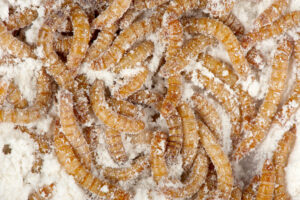 Stored product pests (SPPs) can seriously threaten product integrity, customer trust, and revenue for the food retail industry. These problem insects feed on dried goods and contaminate inventory, leading to spoilage and food waste. They can also be challenging to detect. Recognizing the early signs of SPPs is crucial to protect your stock and avoid reputational damage and financial loss.
Stored product pests (SPPs) can seriously threaten product integrity, customer trust, and revenue for the food retail industry. These problem insects feed on dried goods and contaminate inventory, leading to spoilage and food waste. They can also be challenging to detect. Recognizing the early signs of SPPs is crucial to protect your stock and avoid reputational damage and financial loss.
With peak season approaching, it’s more important than ever for food processing facilities and grocery stores to be proactive in addressing potential infestations. By staying ahead of the problem with regular inspections and effective pest control measures, you can protect your products, minimize risk, and ensure a smooth operation during your busiest time of year.
What are Stored Product Pests?
Stored product pests are insects that infest and feed on dry, non-perishable food products. Common examples include merchant grain beetles, Indian meal moths, and rice weevils. These species can live and breed in goods such as:
- Grains and cereal products: Pests like grain weevils target rice, oats, and flour, damaging grains and causing contamination.
- Dried fruits and vegetables: Indian meal moths infest dried fruits and vegetables, compromising their quality.
- Spices like dry ginger: Spices, including ginger and cinnamon, can be infested by meal moths and other pests, making them unfit for use.
- Nuts and seeds: Rice weevils and pecan weevils are common in nuts and seeds, leading to contamination.
- Cheese and cured meats: Cheese mites and meal moths may infest cheese and dried meats, affecting their quality.
- Dried fish: Biscuit beetles and dermestid beetles target dried fish, causing it to spoil.
- Confectionery: Drugstore beetles infest chocolates and candies, leading to product loss.
- Beans and lentils: Pulse beetles and bean weevils infest beans and lentils, making them unsuitable for consumption.
Because many of these products are stored in bulk, often for extended periods, an infestation can go unnoticed until the damage is widespread. Routine inspections and good storage practices can help detect early signs.
Common Signs of an Infestation
Many visible and physical signs may indicate an active infestation in your retail warehouse, storage unit, or retail floor. Business owners, store managers, and employees should look out for:
- Live or dead insects: Small beetles, weevils, or moths may be found in or around packaging, bins, or shelving.
- Larvae, pupae, or webbing: These life stages are often found in food bins, corners, cracks, or packaging seams.
- Holes in packaging: Some pests chew through cardboard or plastic, leaving tiny holes and allowing more pests to enter.
- Contaminated products: Infested goods may contain insect fragments, cast skins, or droppings.
- Webbing or cocoons: Moths often leave silky threads on food surfaces or around storage areas.
- Product clumping or discoloration: Damaged product can clump together due to moisture from pest activity or appear discolored.
- Activity in traps: Monitoring devices may indicate early pest presence.
These signs can vary depending on the type of pest and severity of the infestation. A more detailed inspection is recommended if your team notices one or more of these indicators.
High Risk Areas for Activity
SPPs often go undetected in quiet corners where food products are stored or displayed in warehouses or on the sales floor. Watch closely for signs in:
- Cracks and crevices in shelving
- Behind or under storage bins
- Machinery or conveyor belts
- Packaging stations
- Near air vents or ceiling beams
While regular cleaning and thorough inspections are vital to prevent or reduce infestations, even areas that appear clean can harbor small populations that can rapidly expand.
Why Stored Product Pests are a Concern for Food Retail
The risks from stored product pests extend beyond damaged inventory. Without early detection and prompt action, these pests can:
- Contaminate food, making it unsellable
- Lead to customer complaints or product recalls
- Result in regulatory non-compliance and financial penalties
- Impact brand reputation and trust
Staff should be trained to spot signs and escalate concerns immediately to minimize these risks. With the high stakes of maintaining product integrity and customer trust, partnering with a pest control provider who understands the food industry’s unique challenges is essential.
Steps to Reduce the Risk of Infestation
You can take immediate preventative action to help protect your retail business from stored product pests:
- Store dry goods off the floor and away from walls
- Use FIFO (First In, First Out) inventory practices to reduce long storage times
- Clean up food spills promptly and thoroughly
- Inspect incoming shipments before storage
- Keep doors and windows sealed
- Use insect monitoring traps in storage and prep areas
RK Environmental specializes in tailored solutions for food retailers and processors, taking a proactive approach to prevent infestations before they begin. We’re here to help you protect your business and maintain product quality. Schedule a complimentary consultation to get ahead today.
How We Can Help?
At RK Environmental Services, we understand the pressures of running a food retail business, particularly over multiple sites. Our technicians are trained in food safety standards to protect food environments from stored product pests and ensure regulatory compliance.
We take a proactive, data-driven approach that includes:
- A comprehensive site inspection to identify signs of activity and potential vulnerabilities
- Ongoing support and advice to improve facility hygiene and pest prevention
- Prevention and monitoring strategies to stop pest infestations before they start
We know that even a single pest sighting can have serious consequences. That’s why we focus on helping you stop infestations before they begin. Our commercial integrated pest management and food safety programs for the food retail industry are tailored to protect your brand.
Frequently Asked Questions
They are often small insects like beetles, weevils, or moths. Larvae, or frass, may look like small worms, are often white or pale, and are a strong indicator of an established infestation.
Infested food may contain insect fragments or droppings and should not be sold or eaten.
They can arrive in shipments, enter through small gaps, or spread from neighboring businesses.
While some DIY steps can help in the short term, working with professionals is the best way to address the root cause and prevent future issues.
Regular inspections, weekly or monthly, can help catch problems early. However, areas with high turnover may need more frequent checks.
Signs of Stored Product Pests
Specializing in pest management & food safety consulting for food processing plants
Home » Signs of Stored Product Pests






